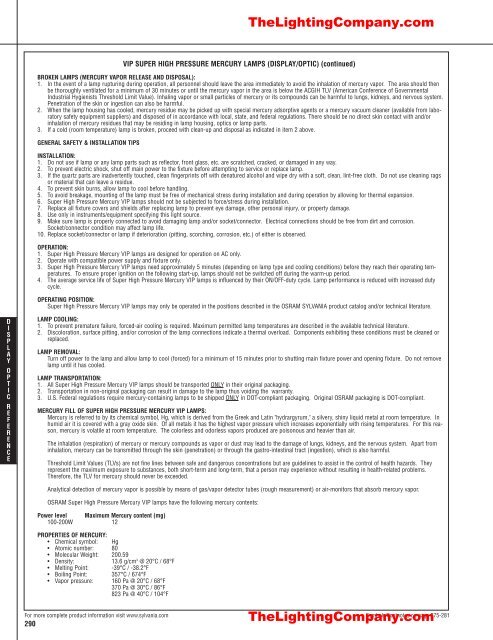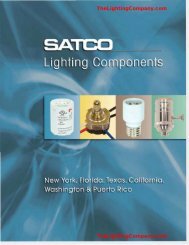Lamp and Ballast Catalog - The Lighting Company
Lamp and Ballast Catalog - The Lighting Company
Lamp and Ballast Catalog - The Lighting Company
- No tags were found...
You also want an ePaper? Increase the reach of your titles
YUMPU automatically turns print PDFs into web optimized ePapers that Google loves.
<strong>The</strong><strong>Lighting</strong><strong>Company</strong>.com<br />
VIP SUPER HIGH PRESSURE MERCURY LAMPS (DISPLAY/OPTIC) (continued)<br />
BROKEN LAMPS (MERCURY VAPOR RELEASE AND DISPOSAL):<br />
1. In the event of a lamp rupturing during operation, all personnel should leave the area immediately to avoid the inhalation of mercury vapor. <strong>The</strong> area should then<br />
be thoroughly ventilated for a minimum of 30 minutes or until the mercury vapor in the area is below the ACGIH TLV (American Conference of Governmental<br />
Industrial Hygienists Threshold Limit Value). Inhaling vapor or small particles of mercury or its compounds can be harmful to lungs, kidneys, <strong>and</strong> nervous system.<br />
Penetration of the skin or ingestion can also be harmful.<br />
2. When the lamp housing has cooled, mercury residue may be picked up with special mercury adsorptive agents or a mercury vacuum cleaner (available from laboratory<br />
safety equipment suppliers) <strong>and</strong> disposed of in accordance with local, state, <strong>and</strong> federal regulations. <strong>The</strong>re should be no direct skin contact with <strong>and</strong>/or<br />
inhalation of mercury residues that may be residing in lamp housing, optics or lamp parts.<br />
3. If a cold (room temperature) lamp is broken, proceed with clean-up <strong>and</strong> disposal as indicated in item 2 above.<br />
GENERAL SAFETY & INSTALLATION TIPS<br />
INSTALLATION:<br />
1. Do not use if lamp or any lamp parts such as reflector, front glass, etc. are scratched, cracked, or damaged in any way.<br />
2. To prevent electric shock, shut off main power to the fixture before attempting to service or replace lamp.<br />
3. If the quartz parts are inadvertently touched, clean fingerprints off with denatured alcohol <strong>and</strong> wipe dry with a soft, clean, lint-free cloth. Do not use cleaning rags<br />
or material that can leave a residue.<br />
4. To prevent skin burns, allow lamp to cool before h<strong>and</strong>ling.<br />
5. To avoid breakage, mounting of the lamp must be free of mechanical stress during installation <strong>and</strong> during operation by allowing for thermal expansion.<br />
6. Super High Pressure Mercury VIP lamps should not be subjected to force/stress during installation.<br />
7. Replace all fixture covers <strong>and</strong> shields after replacing lamp to prevent eye damage, other personal injury, or property damage.<br />
8. Use only in instruments/equipment specifying this light source.<br />
9. Make sure lamp is properly connected to avoid damaging lamp <strong>and</strong>/or socket/connector. Electrical connections should be free from dirt <strong>and</strong> corrosion.<br />
Socket/connector condition may affect lamp life.<br />
10. Replace socket/connector or lamp if deterioration (pitting, scorching, corrosion, etc.) of either is observed.<br />
OPERATION:<br />
1. Super High Pressure Mercury VIP lamps are designed for operation on AC only.<br />
2. Operate with compatible power supply <strong>and</strong> fixture only.<br />
3. Super High Pressure Mercury VIP lamps need approximately 5 minutes (depending on lamp type <strong>and</strong> cooling conditions) before they reach their operating temperatures.<br />
To ensure proper ignition on the following start-up, lamps should not be switched off during the warm-up period.<br />
4. <strong>The</strong> average service life of Super High Pressure Mercury VIP lamps is influenced by their ON/OFF-duty cycle. <strong>Lamp</strong> performance is reduced with increased duty<br />
cycle.<br />
OPERATING POSITION:<br />
Super High Pressure Mercury VIP lamps may only be operated in the positions described in the OSRAM SYLVANIA product catalog <strong>and</strong>/or technical literature.<br />
D<br />
ISPLAY<br />
O<br />
PTIC<br />
R<br />
EFERENCE<br />
LAMP COOLING:<br />
1. To prevent premature failure, forced-air cooling is required. Maximum permitted lamp temperatures are described in the available technical literature.<br />
2. Discoloration, surface pitting, <strong>and</strong>/or corrosion of the lamp connections indicate a thermal overload. Components exhibiting these conditions must be cleaned or<br />
replaced.<br />
LAMP REMOVAL:<br />
Turn off power to the lamp <strong>and</strong> allow lamp to cool (forced) for a minimum of 15 minutes prior to shutting main fixture power <strong>and</strong> opening fixture. Do not remove<br />
lamp until it has cooled.<br />
LAMP TRANSPORTATION:<br />
1. All Super High Pressure Mercury VIP lamps should be transported ONLY in their original packaging.<br />
2. Transportation in non-original packaging can result in damage to the lamp thus voiding the warranty.<br />
3. U.S. Federal regulations require mercury-containing lamps to be shipped ONLY in DOT-compliant packaging. Original OSRAM packaging is DOT-compliant.<br />
MERCURY FILL OF SUPER HIGH PRESSURE MERCURY VIP LAMPS:<br />
Mercury is referred to by its chemical symbol, Hg, which is derived from the Greek <strong>and</strong> Latin "hydrargyrum," a silvery, shiny liquid metal at room temperature. In<br />
humid air it is covered with a gray oxide skin. Of all metals it has the highest vapor pressure which increases exponentially with rising temperatures. For this reason,<br />
mercury is volatile at room temperature. <strong>The</strong> colorless <strong>and</strong> odorless vapors produced are poisonous <strong>and</strong> heavier than air.<br />
<strong>The</strong> inhalation (respiration) of mercury or mercury compounds as vapor or dust may lead to the damage of lungs, kidneys, <strong>and</strong> the nervous system. Apart from<br />
inhalation, mercury can be transmitted through the skin (penetration) or through the gastro-intestinal tract (ingestion), which is also harmful.<br />
Threshold Limit Values (TLVs) are not fine lines between safe <strong>and</strong> dangerous concentrations but are guidelines to assist in the control of health hazards. <strong>The</strong>y<br />
represent the maximum exposure to substances, both short-term <strong>and</strong> long-term, that a person may experience without resulting in health-related problems.<br />
<strong>The</strong>refore, the TLV for mercury should never be exceeded.<br />
Analytical detection of mercury vapor is possible by means of gas/vapor detector tubes (rough measurement) or air-monitors that absorb mercury vapor.<br />
OSRAM Super High Pressure Mercury VIP lamps have the following mercury contents:<br />
Power level Maximum Mercury content (mg)<br />
100-200W 12<br />
PROPERTIES OF MERCURY:<br />
• Chemical symbol: Hg<br />
• Atomic number: 80<br />
• Molecular Weight: 200.59<br />
• Density: 13.6 g/cm 3 @ 20°C / 68°F<br />
• Melting Point: -39°C / -38.2°F<br />
• Boiling Point: 357°C / 674°F<br />
• Vapor pressure: 160 Pa @ 20°C / 68°F<br />
370 Pa @ 30°C / 86°F<br />
823 Pa @ 40°C / 104°F<br />
For more complete product information visit www.sylvania.com Symbols/Footnotes on page 275-281<br />
290<br />
<strong>The</strong><strong>Lighting</strong><strong>Company</strong>.com




